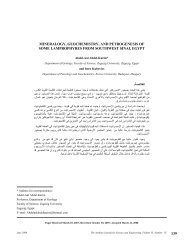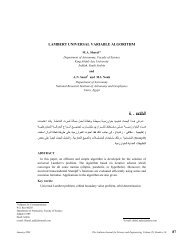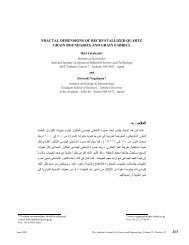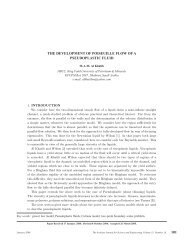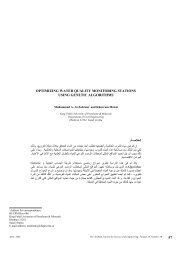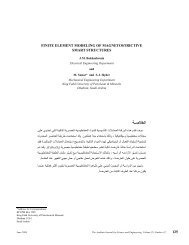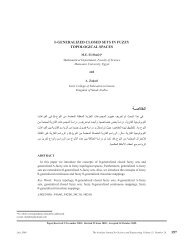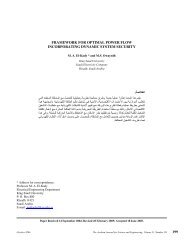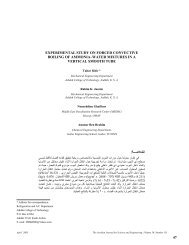HYDRODESULFURIZATION OF THIOPHENE OVER BIMETALLIC ...
HYDRODESULFURIZATION OF THIOPHENE OVER BIMETALLIC ...
HYDRODESULFURIZATION OF THIOPHENE OVER BIMETALLIC ...
You also want an ePaper? Increase the reach of your titles
YUMPU automatically turns print PDFs into web optimized ePapers that Google loves.
Hamid A. Al-Megren<br />
The sol–gel method is the latest technique for catalyst preparation, in which the metal–organic precursors are<br />
mixed with metal precursor to form a homogeneous solution [43]. The solution is passed through the hydrolysis and<br />
polymerization process by adding water while carefully controlling the pH and reaction temperature. This results in<br />
the formation of colloidal particles and micelles of approximately 10 nm diameter. These particles continue to<br />
increase in size until a metal oxide gel is formed.<br />
However, each of these techniques is either difficult to control or the preparation process is complex and difficult<br />
to use on an industrial scale. Also, none of them ever takes into consideration the adjustment of the interaction<br />
between the active metal and support, which is regarded as one of the properties of supported catalysts.<br />
Also, for hydrotreating catalyst preparation, the content and particle sizes of the active components such as Mo or<br />
W are crucial for the catalyst performance. No methods are available to load the high content of the Mo or W needed<br />
with desirable particle size. Hence, selective deep removal HDS now needs noble metal catalysts, which are much<br />
more costly and easy to deactivate.<br />
Recently, a new catalyst preparation method, i.e. organic matrix combustion (OMXC) has been developed [44,<br />
45]. Some organic compounds are mixed with soluble metal compounds to form a homogeneous solution with<br />
addition of minimum water (or other solvent) where necessary. The particle size of the catalyst is controlled by the<br />
ratio of the organic compounds to the metal in the solution. Interaction between the active component and support is<br />
controlled by the calcinations temperature and atmosphere.<br />
The aim of this work is to develop more robust catalysts with high activity for selective removal of sulfur from<br />
thiophene, to hydrogenate the C–S bond; and with low ability to hydrogenate the mono C=C bonds. The key to<br />
achieving this goal is to control the distribution and particle size of the active component, e.g. MoS2, and optimize<br />
the promotion of Ni and Mo in the catalysts supported over alumina. Active component precursors will be chosen<br />
from the ammonium salts. This catalyst will be prepared and compared by three different preparation methods.<br />
2. EXPERIMENTAL<br />
2.1. Catalyst Preparation<br />
In this work, 15% Ni–Mo bimetallic material supported over alumina was prepared using three different<br />
methods: impregnation (IMPR), mechanical (MECH), and organic matrix combustion (OMXC). All catalysts were<br />
prepared in oxide phase then sulfurized using a stream of hydrogen saturated by thiophene at room temperature.<br />
Nickel nitrate hexahydrate Ni(NO3)2.6H2O(99.0% Fluka) was mechanically mixed with molybdenum trioxide at<br />
a Ni/Mo atomic ratio of 0.43. An amount of 15% from the mixture was added to alumina (150 mesh, 150 m 2 g -1 , from<br />
Aldrich). The mixture was dried in a vacuum oven at 120ºC and calcined at 550ºC for 15 hours. The resulted powder<br />
sample was named as MECH.<br />
Nickel nitrate hexahydrate was dissolved in small amount of water, mixed with ammonium<br />
heptamolybdatetetrahydrate (NH4)6Mo7O24-4H2O (99% Riedel-de Haën) then impregnated with alumina. The<br />
mixture was dried in a vacuum oven and calcined at 550ºC for 15 hours. The resulted powder sample was named as<br />
IMPR.<br />
The same ratio of Ni/Mo supported over alumina was prepared using OMXC method by mixing calculated<br />
amount of urea (Fisher Chemicals) with ammonium heptamolybdate-tetrahydrate and nickel nitrate hexahydrate<br />
(Ca.1g/2ml = (Ni- and Mo-Precursors+urea)/ water ratio. This mixture was stirred to form a homogeneous slurry,<br />
then mixed with Al2O3 support and heated at 50ºC for 2-3 hours to obtain urea-based slurry containing molybdenum<br />
fully loaded over alumina. This paste is ignited at 500ºC in static air for 10 min. The resulted powder sample was<br />
named as OMXC.<br />
2.2. Catalytic Tests<br />
All catalysts were activated by sulfurization using 20 ml of hydrogen through a jacketed saturator containing<br />
thiophene (10.9 kPa). The flow of hydrogen with thiophene passed through 200mg of catalyst placed in a fixed bed<br />
reactor and heated at 5ºC/min to maximum temperature 450ºC, and was then held at this temperature for 3 hours.<br />
The catalytic behavior tests of the prepared supported catalysts (MECH, IMPR, and OMXC) for the<br />
hydrodesulfurization of thiophene were carried out in a laboratory bench scale pilot plant fitted with mass flow<br />
meters and a fixed bed down-pass flow quartz reactor placed in a cylindrical furnace, equipped with a coaxial<br />
thermocouple. The inner diameter for the reactor was 4 mm and its length 300 mm. The catalyst zone in the middle<br />
of the reactor had a length of 30 mm and was filled with 200 mg of catalyst diluted with an equal amount of quartz<br />
particles (50 – 100 mesh) in order to minimize temperature gradients. In the center of the catalyst bed, a<br />
thermocouple was installed in contact with the catalyst particles to measure the reaction temperature. The heating<br />
zones at the inlet and the outlet of the reactor were measured by a thermocouple located inside the furnace and were<br />
controlled by a temperature controller (Cole Parmer Digi-Science).<br />
The Arabian Journal for Science and Engineering, Volume 34, Number 1A January 2009 57



